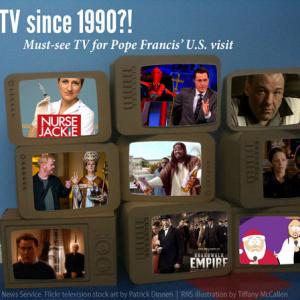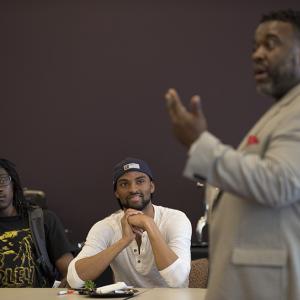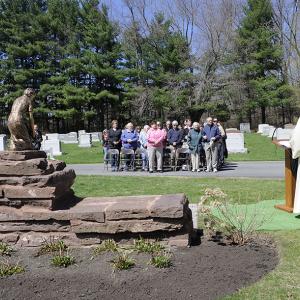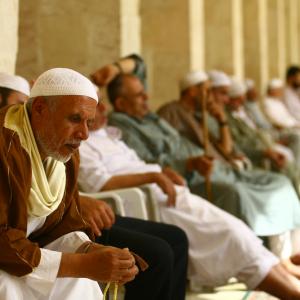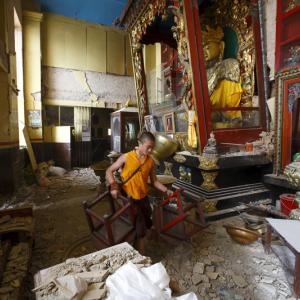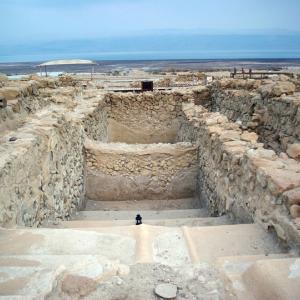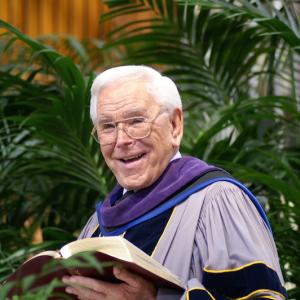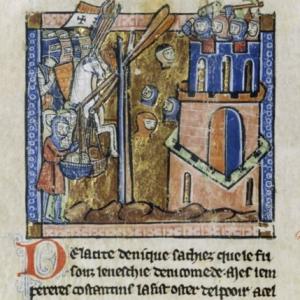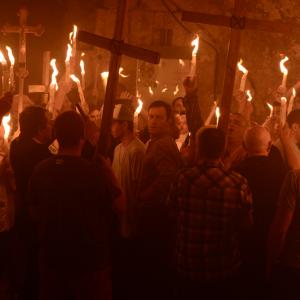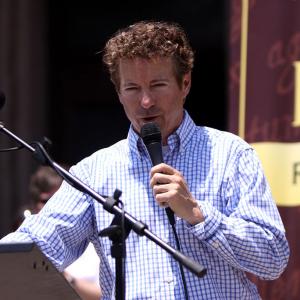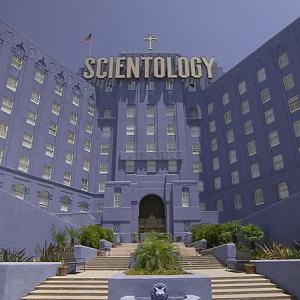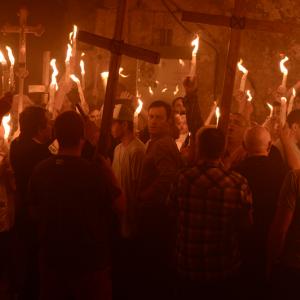
Kimberly Winston is a freelance religion reporter whose work has appeared in the Washington Post, USA Today, and the Chicago Tribune. She is the 2005 recipient of the American Academy of Relgion's award for best religion reporting.
Posts By This Author
African-American Opera Singer Revives the Yiddish Songs of the Shtetl
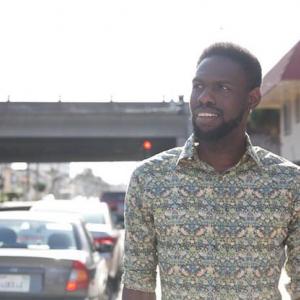
Anthony Mordechai Tzvi Russell. Photo via Clara Rice Photography / RNS
Three years ago, when Anthony Mordechai Tzvi Russell took the stage at a Jewish vaudeville celebration and said he was going to sing in Yiddish, people laughed.
As a 6-foot-plus African-American with one golden earring, he just didn’t look like the typical Jew fluent in the language of the pre-World War II shtetl.
Then he opened his mouth. Out came a rich bass voice in a longing lament to the isolated villages and tiny homes left behind in places like Poland and Russia.
Think Fiddler on the Roof's “Anatevka” sung by a guy who looks more like Chris Rock than Zero Mostel.
How the Vatican Links Human Trafficking, Climate Change, and God
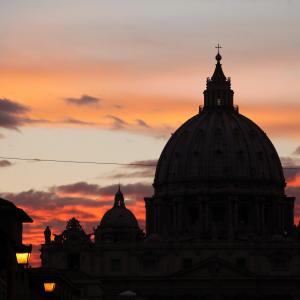
Sunset over the dome of Saint Peter's Basilica in Vatican City. Photo via Vladimir Wrangel / Shutterstock.com
On July 21 and 22, the Vatican hosts two conferences on human trafficking and climate change, bringing the mayors of major cities — including several in the U.S. — to Rome for the events. What do human trafficking and climate change have to do with each other? And what does Catholicism have to do with them? Let us explain.
Q: Why is the Vatican concerned with human trafficking and climate change?
A: If Pope Francis has two pet issues, they are human trafficking and climate change. Since the first year of his papacy he has spoken against human trafficking, calling it “a crime against humanity” and lamenting it as modern slavery. It’s an even bet that when the pope addresses the United Nations in late September he will hammer it as one of the crucial issues of our time. Ditto on climate change. In June, the pontiff published his encyclical — the highest teaching of the church — on climate change.
“Our home is being ruined and that hurts everyone, especially the poorest among us,” Francis said just before the publication of the encyclical.
Jim Gaffigan's Catholic Comedy
Jokes about somebody’s religious beliefs are often duds.
But jokes about your own religious beliefs somehow push the line between funny and offensive, making room for laughter and, occasionally, sharp commentary.
That’s the philosophy behind The Jim Gaffigan Show, a new series premiering on TVLand on July 15 featuring Jim Gaffigan — the popular stand-up comedian known for his Comedy Central special and the books Dad Is Fat and Food: A Love Story — and his wife, Jeannie.
The husband-and-wife team say their Catholicism — with its daily prayer, weekly Mass, and rosary recitation with their five kids — is such a part of their own lives that not including it in their work would be dishonest.
“It’s part of the story,” said Jeannie Gaffigan, an executive producer of the new show and Jim’s frequent collaborator.
5 Faith Facts about Donald Trump: a Presbyterian who Collects Bibles
Donald Trump, the New York rich guy/reality television star/conservative news commentator/real estate mogul/hair disaster, announced he will run for the Republican Party nomination for president of the United States on June 16.
Five Faith Facts About Lincoln Chafee: ‘I Have To Be Respectful of Everyone’
Add one more to the table of Democratic contenders for president in 2016. On June 3 Lincoln Chafee, the Republican-turned-Independent-turned-Democrat who served as both governor and senator of Rhode Island, announced he is in the running. Here are five faith facts about this very dark horse (who used to horseshoe for a living).
1. He’s Episcopalian.
Chafee was raised in the church and his positions on many of the issues largely mirror that of many Episcopalians, one of the more liberal Christian denominations. Chafee supports marriage equality, embryonic stem-cell research, and reproductive choice for women, and he opposes the death penalty.
After Death Threats, Bangladeshi Atheist Relocates to U.S.
An internationally renowned atheist activist has relocated from India to the U.S. after receiving death threats from an extremist group that has claimed responsibility for at least one of three machete killings of South Asian atheists this year.
Taslima Nasrin, a Bangladeshi gynecologist, novelist, and poet, arrived in New York state on May 27. The move was orchestrated by the Center for Inquiry, an organization that promotes secularism and has been working with atheist activists in countries where atheism is unprotected by blasphemy laws.
Can There Be an ‘Atheist Vote’? Nonreligious Set Sights on 2016
As the 2016 election approaches, atheist, humanist, and other freethinking activists are encouraged. They say their longtime goal of creating a cohesive and formidable secular voting bloc from the diverse and scattered category of the nonreligious has taken new life from the study — and could carry them far if they use the data wisely.
“It is going to translate into a lot of political clout and social acceptance if we manage this correctly,” said David Silverman, president of American Atheists.
Pope Francis Hasn’t Watched TV Since 1990. Here Are Some Key Moments He Missed
Pope Francis told an Argentine newspaper on May 25 that he hasn’t watched television since 1990. Think of all he’s missed, not just in terms of popular culture, but also in terms of American Catholicism. Here, in no particular order, are seven television shows the pope might want to catch up on before his September U.S. trip.
‘The New Black’ Opens New Dialogue About LGBT and Religion in Black Community
Is gay marriage a civil right like black equality? Or is it a sin African-Americans should condemn?
That’s the question at the heart of The New Black, a documentary by filmmaker Yoruba Richen that examines African-American attitudes toward LGBT people leading up to Maryland’s public referendum on gay marriage in 2012.
The film is now enjoying a new life as part of an initiative to get students at historically black colleges and universities to talk about a longtime taboo in the African-American community — sexual identity and the church.
For Mother’s Day, a Place to Mourn the Babies Who Never Came Home
None of the remains of the 26 babies — miscarried, stillborn, and short-lived — whose names are engraved on paving stones or metal butterflies at the Remembrance Garden are actually interred there. But to the families who gathered at the memorial last month, the plot is sacred ground.
“The garden says to us: You matter,” Biskup told them.
“Your baby existed. He or she matters. We remember.”
Why Does Islam Ban Images of the Prophet Muhammad?
On May 3 in Garland, Texas, two gunmen opened fire at a “draw the Prophet Muhammad” contest sponsored by the American Freedom Defense Initiative, listed as an extremist group by the Southern Poverty Law Center. Police shot and killed the two gunmen. A security guard was injured. Most Muslims consider images of the prophet highly offensive, as Islam prohibits them. The attack comes almost four months to the day that four cartoonists at the French weekly Charlie Hebdo were killed by extremists offended at the magazine’s satirical depictions of the prophet.
Why do images of the founder of Islam — even cartoons drawn by amateurs — incite so much anger in some people that they are motivated to violence?
Understanding the Religious Sites that Were Lost or Damaged in the Nepal Quake
In one minute, the April 25 earthquake in Nepal toppled, destroyed,and damaged a millennium of religious history. What religious buildings were damaged, and which ones are gone? What religious significance did these buildings have and to whom? Will they be rebuilt? Can they be? Let us explain …
Q: What religions do the Nepalese people follow?
A: About 80 percent of Nepalese are Hindu, making it the second-largest Hindu nation outside of India, with about 2 percent of the global total. But the small, mountainous country is also the birthplace of the Buddha and home to Muslims and Christians, too.
Q: What religious sites are in Nepal and who are they sacred to?
A. The most important religious site in Nepal is Lumbini, west of Kathmandu, just outside the Indian border. Lumbini is sometimes called the “Buddhist Bethlehem” because it is the birthplace of Siddhartha Gautama, the Indian nobleman who became the Buddha, in 623 B.C.
Siddhartha’s mother, Queen Maya Devi, is said to have given birth on the site now marked by Lumbini’s Mayadevi Temple and to have bathed her infant son in its adjacent pool. The ancient part of the site — there are many new temples and monasteries surrounding it — also includes a sacred Bodhi tree, the same type of tree the Buddha is said to have sat under when he attained enlightenment. Archaeologists have found evidence of worshippers at this site as early as 1000 B.C., perhaps members of a pre-Buddhist tree-worshipping sect. The extent of the damage at Lumbini is not yet known because of the difficulty of getting in and out of the area.
Sifting Through Religious Debris in ‘Dig,’ What’s Fact and What’s Fiction?
Trapdoors, secret chambers, and mysterious torch-lit beach rituals. The eighth episode of Dig, the Holy Land conspiracy thriller that aired April 23 on the USA Network, serves up all these classic elements of suspense.
But that heady cocktail comes with a shot of religious history and biblical references that add context to what is already a complex plot involving cloned high priests, murderous rabbis, and the cutest little red heifer ever genetically engineered on a Danish farm. Can you hear religion and popular culture go CRASH?
“It can’t all be crazy, though, can it?” Emma Wilson (Alison Sudol) asks the hot FBI agent on Dig, Peter Connelly (Jason Isaacs), as they look at end-of-the-world messages left behind by a crazed — and dead — archaeologist.
“The messenger, maybe,” Peter replies.
“But not the message.”
“To a nunnery, go!”
Both the bad guys and the good guys descend on a nunnery belonging to a group called the Sisters of Dinah, in search of an antique plaque depicting “the revenge of Dinah.”
The fictional religious order and its equally fictional plaque are derived from the story of Dinah, the daughter of Jacob and Leah. The Book of Genesis tells how Dinah is kidnapped and raped by Shechem, a rival tribesman. Shechem then asks for Dinah’s hand and says her family can ask any “bride-price” they like from his family.
Crystal Cathedral Founder’s Memorial Covered by Crowdfunding Campaign
The Rev. Robert H. Schuller, the “Hour of Power” religious broadcaster, once raised $18 million to build his landmark Crystal Cathedral in Southern California’s Orange County.
Yet when he was laid to rest April 20 on the grounds of the cathedral he longer controlled, his fractured family resorted to crowdfunding to cover the costs.
“Dr. and Mrs. Schuller were left financially crippled by the loss of their retirement income previously promised by the organization,” Carol Schuller Milner, Schuller’s daughter, wrote on the site GoFundMe.
“Living on social security for the past years, they were not able to preserve a fund that would cover arrangements for funeral and memorial tributes.”
Christ Cathedral — the name the Catholic Diocese of Orange, Calif., gave the building after purchasing it in 2012 — and a private benefactor covered the funeral’s basic costs, Milner wrote.
The GoFundMe appeal seeks $30,000 to establish a website, an archive of Robert Schuller’s work, and a broadcast of the funeral.
“The funds we seek will help to give Dr. Schuller a lovely, albeit modest, goodbye,” the appeal said.
To date, a little over $6,100 has been raised from 44 donors. Individual donations have ranged from $25 to $1,000 since the campaign’s start April 11. Schuller died April 2 of esophageal cancer at the age of 88.
Secret Orders and Supposed Traitors — TV’s ‘Dig’ Into Religious History
The pieces of the religious puzzle that make up the USA Network’s biblical conspiracy action series Dig are beginning to fall into place, and the picture they are revealing is one of history — highlighted by a colorful streak of fiction.
Here be spoilers! Read on only if you are up-to-date with the 10-part series, or want to ruin it for yourself and others.
“Order of Moriah”
This secret religious order, supposedly dating from the Crusades, seems to be a product of the Dig writers’ imaginations. But, like many of the show’s fictional aspects, it is based on historical fact.
The Crusades, which mainly took place from 1095 to 1291, were an attempt by the Rome-based Catholic Church to retake the Holy Land — Jerusalem and its environs — away from its Muslim rulers.
During that time, the church founded several monastic religious orders whose members traveled to Jerusalem. Some fought with the armies, some cared for the wounded and sick. The most famous of these orders were the Knights Hospitallers, the Knights Teutonic, and the Knights Templar.
It is perhaps the Templars that the Order of Moriah is based on. Officially named “The Poor Fellow-Soldiers of Christ and of the Temple of Solomon,” the Knights Templar were anything but poor. They owned land from Rome to Jerusalem and were involved in finance throughout the Christian world. They loaned money to King Philip IV of France and the church.
Digging Under Mount Moriah with TV’s ‘Dig’
Archaic prayers, hidden keys, and secret religious orders — such are the elements of the latest episode of the USA Network’s biblical conspiracy action series Dig.
Add in a modern re-enactment of one of the most harrowing stories in the Hebrew Bible, and the result is a swirling, baffling stew of religious themes and imagery.
This is your spoiler alert! Read on if you are up to date on Dig or a glutton for punishment.
“It’s all about the End of Days, the Second Coming, Armageddon, the Rapture,” Debbie (Lauren Ambrose) says in what is the clearest explanation by any character of what is going on in Dig to date.
“In order to bring about the Second Coming, the Temple in Jerusalem needs to be rebuilt.”
Here’s a quick summary of some of the religion references in this week’s episode:
Five Faith Facts About Rand Paul: ‘My Faith Has Never Been Easy for Me’
Sen. Randal Howard “Rand” Paul, the junior Republican from Kentucky, is expected to launch his 2016 campaign on April 7. Here are five facts about the faith background of this libertarian candidate:
- Paul, 52, was baptized an Episcopalian. It didn’t stick. He attended Baylor University, a Baptist school in Texas, then Duke University. He now attends a Presbyterian church. In this, he is like most Americans — all over the map in terms of his religious affiliation.
- At Baylor, Paul joined the NoZe Brotherhood, a secret and controversial society that routinely skewers the school’s Baptist roots and other aspects of undergraduate life. His association with the group came back to bite him in his initial run for the Senate after GQ magazine ran a story claiming NoZe was dedicated to “blasphemy,” and Paul, while high as a kite, helped kidnap a coed and forced her to pray to “Aqua Buddha,” a made-up water idol. Paul threatened to sue the magazine.
'What's Up with All the Eggs?' and Other Classic Easter Questions
This is Holy Week, the most sacred time of year for Christians. It is the time they mark the betrayal, trial, and crucifixion of Jesus, and a week that culminates in Easter Sunday, the day Christians believe Jesus rose from the dead. So what do colored eggs have to do with anything? Let us Egg-‘Splain …
Q: Is Holy Week really a whole week? I only know about Good Friday and Easter Sunday.
A: Holy Week is the entire week between Palm Sunday and Easter Sunday. Not a whole lot happens on Monday and Tuesday, but some Christians mark the crucifixion on Wednesday, and some celebrate Maundy Thursday, the day of the Last Supper, Jesus’ final Passover meal with his disciples. It is sometimes celebrated with a foot-washing ceremony, a tradition beloved by Pope Francis, and a “Pascha” or “Paschal” meal, derived from the Jewish Passover Jesus would have known. Then comes Good Friday, Holy Saturday, and Easter Sunday. Fun fact: Not all American Christians greet each other with “Happy Easter.” To many evangelicals, the day is “Resurrection Sunday,” in part because they believe the word “Easter” has pagan roots.
Q: What is so “good” about Good Friday, the day Jesus was horribly tortured to death?
HBO’s ‘Going Clear’ Questions the Future of Scientology
The only murky thing in Going Clear: Scientology and the Prison of Belief, HBO’s scathing new documentary is: What will happen to the church that sci-fi writer L. Ron Hubbard built more than 50 years ago after it airs?
The two-hour film directed by Academy Award-winning director Alex Gibney is a merciless examination of the Church of Scientology, the religion/business/self-help empire created by Hubbard, who died in 1986. The film, which airs March 29 on HBO, alleges the church has practiced physical, psychological, and financial abuse of its current and former members for decades.
And while the film is based on Pulitzer Prize-winning journalist Lawrence Wright’s 2013 book with an almost identical title, the film manages something the book could not — it allows viewers to look into the eyes of former Scientologists as they describe years of abuse they say they suffered willingly at the hands of the church and the ultimate toll it took: lost relationships, broken lives, empty bank accounts, and more.
The film is so unsparing — particularly in its portrait of David Miscavige, who became the church’s “ecclesiastical leader” after Hubbard’s death and reportedly rules it like a tyrant — that the filmmakers and others who study Scientology say they hope it will prompt internal changes and greater transparency in the church, something it has resisted in the past.
'Dig’ TV Series Starts Adding Up: Watch the Numbers
"Dig," the new action-thriller series from the USA Network, is starting to add up — at least in terms of its religious content.
The third episode, broadcast March 19, advanced plot lines involving an apocalyptic sect of Jews, a desert-dwelling Christian cult, a stolen Torah breastplate rumored to be a telephone to God and a really cute baby cow named "Red" who is having a less-than-excellent adventure.
Tossed like a ball of spices into that potboiler of a story is a difficult biblical text, a secretive society dedicated to restoring the Jewish temple on Jerusalem’s Temple Mount and what may be a nod to Jewish numerology.
"It’s all about XIX," or the number 19, FBI agent Peter Connelly (Jason Isaacs) reads in a journal swiped from a murdered archaeologist.
Here — with spoiler alerts — is what’s behind the newly introduced religious elements to the "Dig" storyline.
Numerology:
Ever notice how in the Bible there are always 12 of this (Tribes of Israel, disciples) and 40 of that (days of rain, years in the desert)? It’s never eight or 11 or — heaven forbid — 17?
That’s because ancient cultures, especially biblical-era Jews, practiced numerology — the belief that numbers have specific religious or spiritual significance. There is a whole branch of study in Judaism called "gematria" by which letters of the Hebrew alphabet are given numerical values and scholars add them up in a search for meaning. The creators of "Dig" seem to be aware of this and are having some fun.
Twice in episode three, the number of Peter Connelly’s hotel room — seven — is pointedly shown. In numerology, seven is considered a perfect number, a "divine" number, the number of God. It represents holiness and sanctification — two themes that pop up over and over again in the search for the "pure" red heifer and the apparent need to keep the boy Joshua’s feet "unsoiled."
And when Peter has a bad dream, his bedside clock reads 11 p.m. In the Bible, 11 represents chaos, disorder, even impurity.
Then there’s that pesky number 19, which is behind much of the episode’s action. In biblical numerology, one is considered the number of God and nine is the number of his judgment. That sounds ominous enough for a thriller-conspiracy-action series like "Dig."





